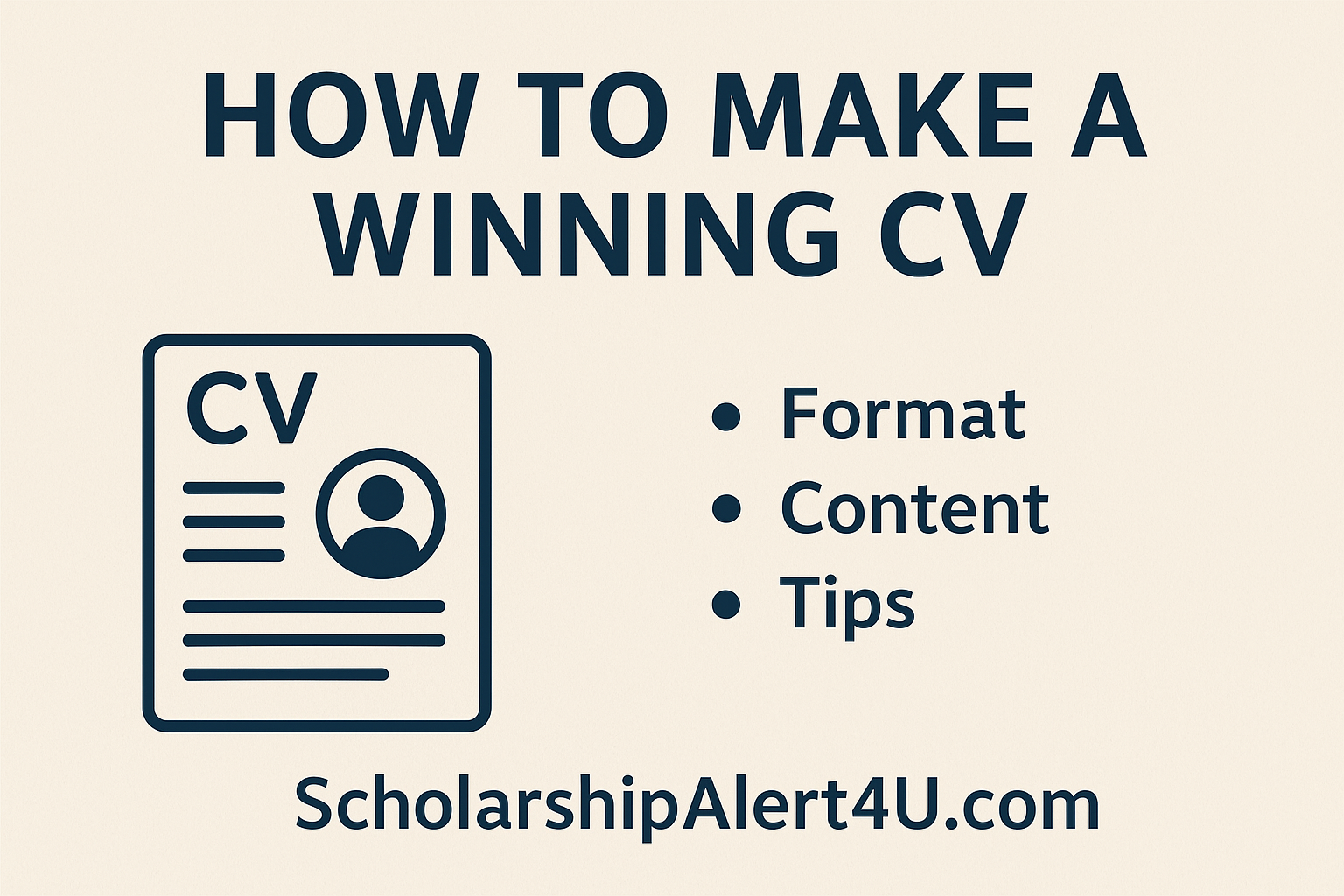A Curriculum Vitae (CV) is more than just a list of your qualifications — it’s your personal marketing tool. Whether you are applying for a scholarship, internship, or your dream job, a professional CV helps employers or selection committees quickly see why you’re the right candidate. Writing one requires clarity, structure, and strategy.
In this article, you’ll learn how to create a polished CV that stands out.
What is a CV?
A CV (Curriculum Vitae) is a detailed document that outlines your academic achievements, work experience, skills, and accomplishments. Unlike a résumé, which is typically one page, a CV can be longer and more comprehensive, especially if you’re applying for scholarships, research positions, or academic roles.
Focus Keywords:
- Winning CV for scholarships
- Scholarship CV tips
- CV format for scholarship applications
- How to write a scholarship CV
Step-by-Step Guide to Writing a Professional CV
1. Choose the Right Format
Your CV should be clean, professional, and easy to read. The three most common CV formats are:
- Chronological: Lists your experience in reverse order (most recent first).
- Functional: Focuses on skills and achievements rather than work history.
- Combination: Blends both formats, highlighting skills and career history.
For most job or scholarship applications, a chronological format works best.
2. Start with Contact Information
At the top of your CV, include:
- Full name
- Phone number
- Professional email address
- LinkedIn profile (optional)
- Location (city and country)
3. Write a Strong Personal Statement
This is a short paragraph (3–4 sentences) that highlights:
- Who you are
- Your career goals
- Key skills or achievements relevant to the role
Example:
A motivated business graduate with strong analytical skills and leadership experience, seeking opportunities to apply data-driven decision-making in a fast-paced global environment.
4. Highlight Education
List your academic qualifications starting with the most recent:
- Degree, university, and graduation year
- Awards, honors, or distinctions
- Relevant coursework (if limited experience)
5. Showcase Work Experience
Include your work history in reverse order. For each role, list:
- Job title
- Company/organization name
- Dates of employment
- Key responsibilities and achievements (use bullet points)
Use action verbs like managed, developed, created, implemented, led, or achieved.
6. Add Skills Section
Employers and scholarship committees want to see your skills at a glance. Include:
- Technical skills (software, languages, tools)
- Soft skills (leadership, teamwork, communication)
- Industry-specific skills (if applicable)
| Discover related topics |
| Study in UK Chevening Scholarship 2025 |
| Australia University Scholarship |
| Deakin University Scholarship 2025 |
7. Mention Achievements & Awards
If you have scholarships, publications, certifications, or other achievements, create a separate section.
8. Include Extracurricular Activities (Optional)
For students or fresh graduates, activities such as volunteering, student organizations, or projects can add value.
9. Keep It Concise and Professional
- Use a clear font (Arial, Calibri, Times New Roman)
- Stick to 1–2 pages (unless applying for academic/research roles)
- Avoid spelling and grammar errors
- Don’t include unnecessary personal details (like age, marital status, or photo, unless required)
Frequently Asked Questions (FAQs):
1. What is the difference between a CV and a résumé?
A CV is usually more detailed and highlights your academic background, research, and professional achievements. A résumé is shorter (1 page) and focuses mainly on work experience and skills.
2. How long should a professional CV be?
Ideally, 1–2 pages for most applications. Academic or research CVs may be longer if you have publications or extensive experience.
3. Should I include a photo on my CV?
In most countries, a photo is not required unless specified. However, some regions (like parts of Europe or Asia) may prefer it. Always check the application guidelines.
4. What skills should I put on my CV?
Include both technical skills (e.g., software, languages) and soft skills (e.g., leadership, communication). Tailor the skills to match the role or scholarship you’re applying for.
5. How do I make my CV stand out?
Use clear formatting, highlight measurable achievements, include action verbs, and tailor your CV to each opportunity instead of sending the same version everywhere.
6. Can I use the same CV for jobs and scholarships?
Not exactly. While the base content may be the same, tailor your CV differently. For scholarships, emphasize academic achievements and extracurricular activities. For jobs, focus on professional skills and work experience.
7. What should I avoid including in a CV?
Avoid unnecessary personal details like marital status, religion, or age unless specifically required. Also, don’t include unrelated work history or vague statements.
Final Tips for a Winning CV
- Tailor your CV to the specific job or scholarship.
- Quantify achievements (e.g., “Increased sales by 20% in 6 months”).
- Update your CV regularly.
- Save it in PDF format before submitting.
Conclusion
A well-structured CV is your gateway to new opportunities. By presenting your experience, skills, and achievements in a clear and professional way, you increase your chances of making a strong impression. Remember: your CV is not static — keep refining it as you grow in your career.
Disclaimer
The information provided in this article, “How to Write a Professional CV”, is for general guidance and educational purposes only. While every effort has been made to ensure accuracy and usefulness, ScholarshipAlert4u does not guarantee that following these tips will result in employment, scholarships, or admissions.




One comment on “How to Make a Winning CV for Jobs, Scholarships & Internships”